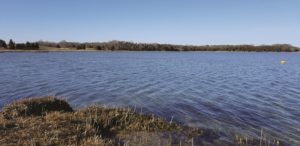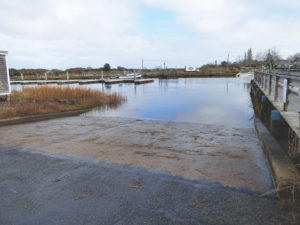EASTHAM — On any other sunny spring day, Fort Hill would be dotted with hikers, dog-walkers, and nature lovers. But on March 12, the historic grassland that overlooks Nauset Marsh was instead populated by a crew of workers clad in flame-resistant gear and carrying drip torches and backpacks full of water.

They were here to perform a 14-acre prescribed burn. Historically, such burns were a regular and important component of the Seashore’s forest management strategy, but since Park Fire Management Officer David Crary Jr.’s retirement on Jan. 1, 2022, the park has not been able to carry any out. In addition, for the two years before his retirement, the work was curtailed by the pandemic, Crary told the Independent. The Fort Hill fire represents the first significant prescribed burn in the National Seashore since 2019.
“Hopefully, this will get people excited about fire again,” said Karen Kopper, National Park Service ecologist for the Northeast Region, who was in town from her base in Springfield for the controlled burn at Fort Hill. Prescribed burns serve to improve habitat, but they are also a safety strategy, used to establish firebreaks to prevent the spread of wildfires.
According to Crary, before his retirement, Seashore staff aimed to do a controlled burn on half of Fort Hill every spring while mowing the other half every fall. This regimen, he said, allowed the ecosystem to regenerate without harming animals that relied on the taller grasses. This strategy was part of Crary’s larger management plan during his time as fire management officer, which called for 500 acres of land to be cleared mechanically or by burning every year — though he did not always reach that target, he said.

The Seashore posted Crary’s job in April 2024, but in November it had still not filled the position and needed to repost it. Deputy Supt. Leslie Reynolds told the Independent at that time that “the cost of living on Cape is challenging for so many, and it also affects the Seashore’s ability to hire this position.”
Now, thanks to a federal hiring freeze that President Trump initiated by executive order on Jan. 20, the fire management position will not be filled for the foreseeable future.
Fire for the Ecosystem
Periodic fires are part of the ecosystem of the Outer Cape, Kopper said. Historically, most of the Outer Cape would have experienced periodic fires, either caused by lightning or set purposely by Indigenous people, who used fire to shape the landscape, according to information posted on the NPS website. The advent of European colonization ended this practice and led to widespread fire suppression across North America, but prescribed burning can help to mimic this historic use of fire on a small scale.

“We should do more burns,” said Seashore Supt. Jennifer Flynn at the Fort Hill burn. “We need lots of little fires instead of big fires.”
Kopper noted that the primary goal of this burn was hazard fuel reduction — Fort Hill’s extensive dry vegetation and proximity to structures make it a particularly dangerous place for a fire to begin, so burning it in advance creates a “fuel break” that prevents an accidental fire from spreading.
As for its ecological benefits, Kopper said that without burning grasslands, a thick layer of thatch builds up that makes it difficult for new plants to grow. Fire turns that thatch into ash, opening up the soil to sunlight and providing nutrients for new plants. Burning in the dormant season is particularly beneficial, she said, because it helps foster spring growth.

Tom Fielden, the fire management officer at the New River Gorge National Park and Preserve in West Virginia, who was the “burn boss” for the Fort Hill burn, said that at Fort Hill fire helps control the abundance of non-native species like multiflora rose that would dominate the meadow if left unchecked. “It’ll want to take over, and then it’ll start choking out all the native grasses,” he said.
Kopper agreed. “We’ll have more of the natives and flowering plants and grasses than you would if you just had this dead thatch layer,” she said. She expects the burned section of Fort Hill to have many more wildflowers and thicker green grass come spring.
The Day of the Burn
The crew of some 20 people who assembled at Fort Hill that Wednesday included representatives from the Seashore, Acadia National Park, Delaware Water Gap National Recreation Area, New River Gorge National Park and Preserve, and the Mass. Dept. of Conservation and Recreation.

The crew kept a constant eye on the weather, radioing each other up-to-date measurements on wind speed, air temperature, humidity, wet bulb temperature, and fine dead fuel moisture — a measurement of the moisture content of smaller fuels like dead grass, leaves, and twigs. These numbers were recorded to ensure the burn was “within prescription” as outlined by the burn plan, Kopper said.
In preparation for the burn, which covered the south-facing portion of the hill, NPS staff mowed a perimeter, raked all dead vegetation around it, and sprayed the surrounding vegetation with water to prevent flying embers from starting smaller fires, Fielden said.
On the morning of the burn, the wind was higher than anticipated, and Kopper said the fire might have to be delayed. “If we’re not in prescription, it’s definitely better not to,” she said. But the crew lit a small test fire near the base of the hill at 11:20 a.m. and watched what happened. As the fire burned, Fielden felt comfortable with its behavior, and at 11:45 a.m., he called for the burn to begin.
The crew worked slowly, using drip torches to add small amounts of fire on the leading edge of the burn. The goal, Kopper explained, is to let the flame slowly back up the hill as it consumes the dry vegetation.
As the fire grew, the column of smoke traveled south, flowing down Town Cove toward Orleans, where homeowners in the smoke’s path had been notified by NPS staff, Kopper said. Here the wind proved helpful, as it quickly dissipated the smoke, Fielden said. By 4:30 p.m., the burn was complete. “It went well,” Fielden said.





